Cutting-edge heart valve repair keeps patients active
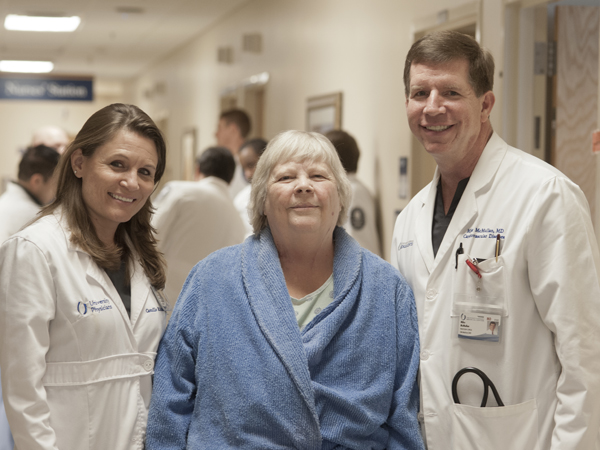
Natchez retiree Betty Smith loves tending to her garden and enjoying the birds who frequent it.
She and her husband Charles “usually stay in the yard,” Smith said. But in recent months, her health has taken away that joy.
“I’d give out all of a sudden,” said Smith, 65, a grandmother of four and survivor of two unrelated cancers. “I felt like someone had drained all the energy out of me. I was constantly tired. I had a lot of dizziness, and I really didn’t know why.”
Her doctors at the University of Mississippi Medical Center’s University Heart discovered she had bilateral carotid stenosis, or narrowing of her carotid arteries. It’s triggered by the buildup of fatty substances and cholesterol deposits, decreasing blood flow to the brain and putting a person at risk for stroke.
But thanks to their comprehensive examination and testing, Smith’s physicians also discovered a second dangerous malady with similar symptoms: aortic valve stenosis, a form of heart disease in which the valve that regulates blood flow from the heart doesn’t fully open. Smith’s quality of life was greatly compromised by her fatigue and shortness of breath, especially with exertion.
Surgeons cleared her carotid arteries in two procedures, one in July and the second in September. Her aortic valve stenosis, however, was repaired Nov. 19 when she became the first patient at UMMC to undergo transcatheter aortic valve replacement, known as TAVR.
Instead of making an incision in Smith’s chest to replace her faulty valve, her heart valve team used a minimally invasive approach. A catheter about the size of a pen was inserted into the artery in her leg and carefully passed up into her heart.
A new artificial valve was gently compressed over a balloon device at the end of the catheter. When the balloon was inflated, the new valve expanded within the faulty valve, immediately improving blood circulation to Smith’s body.
“That’s the beauty of the workups we do,” said Camille Richards, a family nurse practitioner and director of UMMC’s adult congenital and structural heart programs. “We find a lot of other problems.”
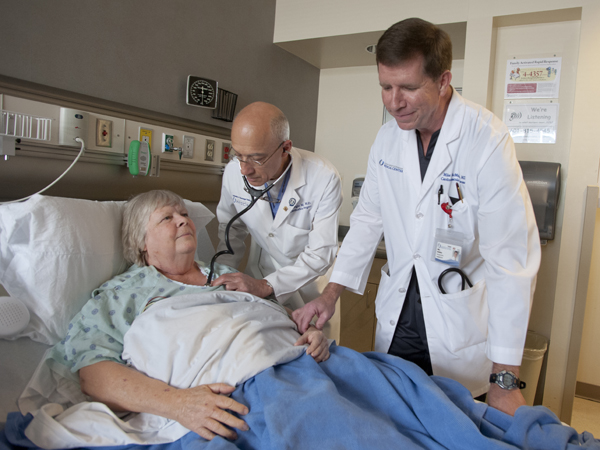
McMullan, right, and Aru check in on their patient
The TAVR procedure lasts about an hour and a half, compared to three to four hours for an open-heart surgery, said Dr. Michael McMullan, professor of cardiology and a member of the heart valve team.
Others on the team include Dr. Jorge Salazar, professor of surgery and chief of cardiothoracic surgery; Dr. Cameron Guild, associate professor of cardiology; and Dr. Giorgio Aru, professor of cardiothoracic surgery.
“Dr. Guild is the face of TAVR for the Medical Center and is leading the program,” Salazar said. “TAVR is part of an array of services that we offer to take care of the sickest patients in the state. Now that we have this in place, UMMC is fully prepared to handle all heart circumstances.”
When she was first told about the TAVR procedure, “I was nervous,” said Smith. “But after I met Camille, I said, ‘Whatever you want to do.’ Everyone has taken such good care of me.”
Immediately following the surgery, Smith said, she felt “100 percent better.”
“She was sitting up in a chair hours afterward,” McMullan said. “She had immediate symptom improvement.” That type recovery, he said, “is definitely not as quick with an incision.”
She spent one night in intensive care, but was moved to a regular room the next day. “Camille told me my legs might be sore, but they haven’t. I’ve been to the exercise room. I’ve walked three times around the building,” Smith said.
“I started to do the stairs, but I thought that might be a little much.”
And, a minimally invasive procedure was a boon given Smith’s bout with cancer a decade ago. She was treated for stage 3 melanoma and stage 2 breast cancer.
“Because I had chemotherapy and radiation for the breast cancer, I was told then that surgery could be hard on me and that I’d be more likely to get pneumonia,” Smith said as she prepared to be discharged just two days after the procedure. “But, I haven’t had any problems.”
Her heart team has been delighted with her progress, and Aru teased Smith the day she went home. “Now you have more blood going through head. Your IQ will be four digits higher,” he joked.
The TAVR procedure is only used for patients who have severe, symptomatic aortic stenosis, Richards said. “There’s no drug therapy for this, so the only way to make her feel better and live longer is to replace her valve,” McMullan said. “And, it’s nice to be able to do this without opening her chest.”
Although it wasn’t needed during Smith’s surgery, Salazar said, UMMC is the only hospital in the state that uses a specialized piece of equipment called ECMO, short for extra corporeal membrane oxygenation. It’s on standby in the OR for use at a moment’s notice.
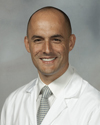
Salazar
“ECMO is a portable heart-lung machine that allows us to stabilize patients while we’re doing a procedure to help them better recover,” he said. “It’s not the same thing as a ventilator, but it lets the heart and lungs rest during surgery so that the heart can recuperate and take off on its own. It allows us to extend therapy to even sicker patients.”
The heart valve team performed University Heart’s third TAVR procedure Wednesday, Salazar said. “The first two patients are both home and doing very well,” he said.
“Dr. Salazar’s vision for this is why it came about here,” McMullan said. “He really pushed TAVR.”
Smith will return to University Heart Dec. 19 for her one-month check. “This valve should last her for a good long time,” Richards said.
Smith is grateful for a procedure that comes at a very pivotal time in her life, and in her family’s history. “Next year, my three granddaughters will graduate from high school,” she said. “Now I can go shopping with them, and I won’t have to stop at the first chair and wait for them to finish.”
When she and Charles left home for her TAVR, “it was dark, and 2 in the morning. We were headed toward Jackson, and we saw a shooting star. I thought, ‘That’s a sign from the Lord.’ I knew that my father and mother were both watching out for me.
“We did my heart on my father’s birthday. He would have been 101.”
Photos
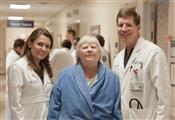 | High Resolution Medium Resolution Low Resolution |
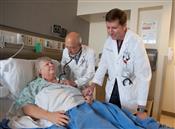 | High Resolution Medium Resolution Low Resolution |
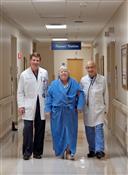 | Faculty On-Boarding content High Resolution Medium Resolution Low Resolution |


